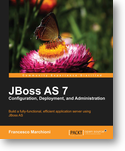
JBoss 7 is the latest Java EE application server to be released by Red Hat. Version 7 is certified against the Java EE 6 Web Profile and has been developed with productivity and speed in mind – the current version offering significant speed enhancements over previous versions. Not only is AS7 available as a download for developers, it is also an important aspect of Red Hat's OpenShift Platform-as-a-Service (PaaS) offering. JBoss AS 7 Configuration, Deployment and Administration explains how to use all the components that make up the application server covering (as you would expect from the title) configuration, management, deployment and administration. Many of these features are different in AS 7 from previous versions of JBoss AS so this book is in invaluable resource. The book is aimed at administrators, developers and testers, so whatever your role, chances are you will find something useful in the book.
The book starts by showing how to download and install AS7. The procedure here is pretty much the same as for other versions of JBoss, so if you've used it before, you shouldn't experience any problems here. What is different however is the structure of the application server itself and the tools used to interact with it. The first chapter of the book explains how the new server is different from previous releases and begins to explain the basics of the server.
After introducing AS7, the book continues to go further into depth on the configuration side of the server. Configuration of thread pools, logging, datasources and EJB etc. is all covered in depth. Plenty of sample XML and diagrams are used to help with the discussions. The book also includes a chapter on configuring and managing JBoss domains which includes useful reading for those implementing and installing JBoss servers.
One of the main pieces of functionality in an enterprise application is probably handled via the Web Container. The book provides plenty of details on how to configure the JBoss Web Container and includes sample Eclipse based source code showing how to create and deploy a basic web application. Note that the emphasis throughout the book is on how the application server can be configured and maintained and not on how to develop Java EE applications. It is useful, from a developer's perspective, to occasionally see some source code to see the interaction with the server however.
In previous versions of the JBoss Application Server, managing the application server (for example creating datasources or JMS queues) was typically performed via manually editing XML files or via the JMX console. With AS 7, both a comprehensive CLI and Web Console are provided. The book contains extensive details of these together with details of how they can be configured.
For those interested in installing JBoss AS, the next few chapters will be extremely useful. Clustering and load balancing are described in-depth with many details included, for example different caching configuration and integration with Apache HTTP Server using mod_jk.
The final chapter of the book discusses cloud computing and how this relates to JBoss AS 7 in the form of OpenShift Express and OpenShift Flex. The author explains these services and then shows how to deploy and manage a simple Java EE application to the services. Given the nature of cloud computing, I believe these chapters will be essential reading for most developers.
If you're developing Java EE applications using JBoss AS 7, or planning to upgrade to AS 7 sometime soon, then I'd recommend this book. The book is useful to new users of AS 7 as well as to those that have been using the AS since it was first released as version 7 last year. Different sections of the book will appeal to different audiences (administrator, developer, tester etc.), but I think the use you'll get from this book will be invaluable.
Recommended reading for all users of JBoss AS 7
Thanks to Sean at Packt Publishing for sending me a copy of this book to review.
JBoss AS 7 Configuration, Deployment, and Administration by Francesco Marchioni. ISBN 978-1-84951-678-5
Don't forget you can win a free copy of this book by commenting about it on the Forums.
